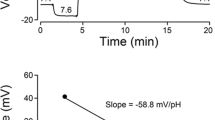Summary
The effects of different organic compounds that block and increase Ca2+ influx through the voltage-sensitive calcium channels (VSCC) on the nocturnal serotonin N-acetyltransferase (NAT) activity was investigated in vivo in rats. Systemic administration of VSCC antagonists, i.e. nimodipine, nifedipine, verapamil and diltiazem, resulted in a marked suppression of the nighttime pineal NAT activity. Bay K 8644, a VSCC agonist, injected to rats before the time of the light offset of the light-dark cycle significantly enhanced the nocturnal increase of the pineal NAT activity. Although Bay K 8644 given during the dark phase of an imposed illumination cycle had little effect on the nocturnal pineal NAT activity, it antagonized the nimodipine- and verapamil-induced decrease in the enzyme activity. These results support the role of Ca2+ influx through the VSCC in the nocturnal increase of NAT activity in the pineal gland of rat.
Similar content being viewed by others
References
Auerbach DA, Klein DC, Woodard C, Aurbach GD (1981) Neonatal rat pinealocytes: typical and atypical characteristics of [125I]iodohydroxybenzyl-pindolol binding and adenosine 3′, 5′-monophosphate accumulation. Endocrinology 108: 559–567
Avendano G, Butler BJ, Iuvone PM (1990) K+-evoked depolarization induces serotonin N-acetyltransferase activity in photoreceptor-enriched retinal cell cultures. Involvement of calcium influx through L-type channels. Neurochem Int (in press)
Bean BP (1989) Classes of calcium channels in vertebrate cells. Annu Rev Physiol 51: 367–384
Deguchi T (1979) Role of adenosine 3′, 5′-monophosphate in the regulation of circadian oscillation of serotonin N-acetyltransferase in cultured chicken pineal gland. J Neurochem 33: 45–51
Ebadi M, Govitrapong P (1985) Neural pathways and neurotransmitters affecting melatonin synthesis. In: Wurtman RJ, Waldhauser MD (eds) Proceedings of the First International Congress on Melatonin in Humans. Center for Brain Sciences and Metabolism. Charitable Trust, Cambridge, USA, pp 123–152
Harrison NL, Zatz M (1989) Voltage-dependent calcium channels regulate melatonin output from cultured chick pineal cells. J Neurosci 9: 2462–2467
Henry PD (1980) Comparative pharmacology of calcium antagonist: nifedipine, verapamil and diltiazem. Am J Cardiol 46: 1047–1058
Iuvone PM, Besharse JC (1986) Involvement of calcium in the regulation of serotonin N-acetyltransferase in retina. J Neurochem 46: 82–88
Johansson BW (1978) Clinical aspects of Ca-blocking agents. Acta Pharmacol Toxicol (Copenh) 43 [Suppl 1]: 45–50
King TS, Steinlechner S (1985) Pineal indolalkylamine synthesis and metabolism: kinetic considerations. Pineal Res Rev 3: 69–113
Klein DC, Berg GR, Weller JL (1970) Melatonin synthesis: adenosine 3′, 5′-monophosphate and norephinephrine stimulate N-acetyltransferase. Science 168: 975–980
Klein DC, Sudgen D, Weller JL (1983) Postsynaptic α1-adrenergic receptors potentiate the β-adrenergic stimulation of pineal serotonin N-acetyltransferase. Proc Natl Acad Sci U.S.A. 80: 599–603
Means AR, Dedman JR (1980) Calmodulin in endocrine cells and its multiple roles in hormone action. Mol Cell Endocrinol 19: 215–227
Means AR, Lagace L, Guerriero V, Chafouleas JG (1982) Calmodulin as a mediator of hormone action and cell regulation. J Cell Biochem 20: 317–330
Meyer AC, Nieuwenhuis JJ, Kociszewska VC, Joubert WS, Meyer BJ (1986) Dihydropyridine calcium antagonists depress the amplitude of the plasma melatonin cycle in baboons. Life Sci 39: 1563–1570
Miller RJ (1987) Multiple calcium channels and neuronal function. Science 235: 46–52
Morrissey JJ, Lovenberg W (1978) Protein synthesis in pineal gland during serotonin N-acetyltransferase induction. Arch Biochem Biophys 191: 1–7
Morton DJ, Reiter RJ, Buzzell GA (1989) Swimming-induced suppression of rat pineal melatonin is prevented by calcium channel blockers. Proc Soc Exp Biol Med 190: 105–108
Nowak JZ (1990) Control of melatonin formation in vertebrate retina. Adv Pineal Res 4: 81–90
Nowak JZ, Zurawska E, Zawilska J (1989) Melatonin and its generating system in vertebrate retina: circadian rhythm, effect of environmental lighting and interaction with dopamine. Neurochem Int 14: 397–406
Reiter RJ (1984) Pineal indoles: production, secretion and actions. In: Muller EE, MacLeod RM (eds) Neuroendocrine perspectives, vol 3. Elsevier, Amsterdam, pp 345–377
Schramm M, Towart R (1985) Modulation of calcium channel function by drugs. Life Sci 37: 1843–1860
Steinlechner S, Champney TH, Houston ML, Reiter RJ (1984) Simultaneous determination of N-acetyltransferase activity, hydroxyindole-O-methyl-transferase activity, and melatonin content in the pineal gland of the Syrian hamster. Proc Soc Exp Biol Med 175: 93–97
Sugden D (1989) Melatonin biosynthesis in the mammalian pineal gland. Experienta 45: 922–932
Sugden AL, Sugden D, Klein DC (1986) Essential role of calcium influx in the adrenergic regulation of cAMP and cGMP in rat pinealocytes. J Biol Chem 261: 11608–11612
Sugden D, Klein DC (1984) Rat pineal alpharadrenoceptors: identification and characterization using [125I]iodo-2[beta-(4-hydroxyphenyl)-ethylamino-methyl]tetralone. Endocrinology 114: 435–440
Zatz M (1989) Relationship between light, calcium influx and cAMP in the acute regulation of melatonin production by cultured chick pineal cells. Brain Res 477: 14–18
Zatz M, Romero JA (1978) Effects of calcium-free medium on the induction of serotonin N-acetyltransferase in the rat pineal. Biochem Pharmacol 27: 2549–2553
Zatz M, Mullen DA (1988 a) Photoendocrine transduction in cultured chick pineal cells (II): effects of forskolin, 8-bromocyclic AMP and 8-bromocyclic GMP on the melatonin rhythm. Brain Res 453: 51–62
Zatz M, Mullen DA (1988 b) Does calcium influx regulate melatonin production through the circadian pacemaker in chick pineal cells? Effects of nitrendipine, Bay K 8644, Co2+, Mn2+, and low external Ca2+. Brain Res 463: 305–316
Zatz M, Kebabian JW, O'Dea F (1978) Regulation of β-adrenergic function in the rat pineal gland. In: Birnbaumer L, O'Malley BW (eds) Receptors and hormone action, vol 3. Academic Press, New York, pp 195–219
Zawilska J, Nowak JZ (1990) Calcium influx through voltage-sensitive calcium channels regulates in vivo serotonin N-acetyltransferase (NAT) in hen retina and pineal gland. Neurosci Lett 118: 17–20
Author information
Authors and Affiliations
Rights and permissions
About this article
Cite this article
Zawilska, J.B., Nowak, J.Z. Calcium channel drugs affect nocturnal serotonin N-acetyltransferase (NAT) activity in rat pineal gland. J. Neural Transmission 84, 171–182 (1991). https://doi.org/10.1007/BF01244968
Received:
Accepted:
Issue Date:
DOI: https://doi.org/10.1007/BF01244968



